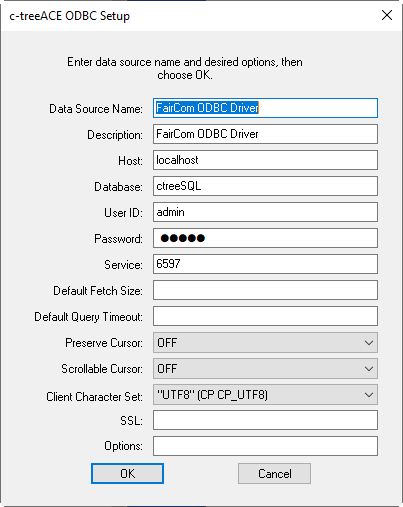The ODBC Data Source Administrator is a Microsoft utility to configure ODBC data sources and drivers.
ODBC uses the term "data source" to refer all the information an application needs to connect to a particular database. This information includes the driver name and location, network address, network software, and database name. Depending on the version of Windows, the ODBC Data Source Administrator stores data source information in text files or in the system registry.
The ODBC Data Source Administrator lets you enter the connection details for accessing a FairCom DB database and associate it with a data source name that users refer to when they need to access the data through an ODBC application.
The FairCom DB ODBC driver installation procedure installs the ODBC Driver Manager software and the associated ODBC Data Source Administrator utility if it was not already installed. To configure the ODBC data source, invoke the ODBC Data Source Administrator Utility:
Once you invoke the ODBC Data Source Administrator:

Data Source Name - A local name for the FairCom DB SQL data source for use in connect calls and by the ODBC Administrator.
Description - Optional descriptive text.
Host - Specify the machine name on which the FairCom DB SQL Server is running.
Database - The name of the database where the FairCom DB SQL data source resides.
User ID / Password - User name and password for connecting to the database. The driver uses those values if the application does not supply them in the call. You can leave these fields blank if you want the driver to use the defaults on the server. If no defaults are defined and you leave these fields blank, the user will be prompted when the application connects.
Service - The name of the Service FairCom DB SQL listens to. If empty, sqlnw is used.
Default Fetch Size - This value is the size (in bytes) used by the driver to fetch multiple rows from the server. It reduces network requests resulting in performance gains. If not set, the internal buffer size is 5000 bytes.
Connection string settings take precedence over DSN and ODBC.INI settings.
Default Query Timeout - It is possible to set the Default Query Timeout (in seconds) in the DSN and in the connection string.
Settings in the connection string take precedence over the setting in the DSN or ODBC.INI.)
Preserve Cursor - This behavior is configurable from within the ODBC administrator.
Scrollable Cursor - This allows you to enable support for ODBC applications that require a scrollable cursor.
Client Character Set - Use the drop-down list to select the character set used by the client.
SSL - Enter optional parameters to configure the SSL. The following entries can be used to configure the SSL connection:
1) empty - Do not use SSL.
2) BASIC - Use SSL without certificate checking.
3) <certificate file name> - Use SSL with certificate checking using the certificate file specified. If no path is entered, the file must be in the current working directory.
Options - Enter any optional parameters to be included in the connect string.
Configuring SSL in Your Connection String
In the ODBC connection string, it is possible to add "SSL=xyz" where "xyz" is one of the options 2 or 3 from the SSL parameters listed above in the FairCom DB ODBC Setup dialog box.
You can add one of the following to your existing ODBC connection strings to enable TLS/SSL:
"SSL=BASIC" - Encryption with default server certificate.
"SSL=ctsrvr.pem" - Use Peer authentication with explicitly named cert located in the local directory.
"SSL=C*\certs\ctsrvr.pem" - Use Peer authentication with an explicitly named cert with a full path.
You can modify or delete a FairCom DB SQL data source after you add it. Invoke the ODBC Data Source Administrator and select the data source you want to modify or delete. Then choose the Configure or Remove button:
When you modify a data source, the ODBC Data Source Administrator modifies the entry for the data source name you specify. For example, you could modify a FairCom DB SQL data source to change the user name and password that connections use.
When you delete a data source, the ODBC Data Source Administrator deletes the entry for that data source. (Deleting a data source has no effect on any database, only on ODBC’s information for accessing the database.)